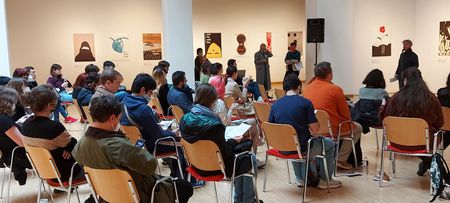On October 30, 2021, Blinken OSA welcomed students from CEU’s History Department and the interuniversity program History in the Public Sphere (HIPS) at the Archives. Since CEU’s forced move to Vienna and the COVID-19 pandemic, the Archives has come up with innovative methods to reach future researchers by digitizing its holdings and providing researchers with remote access. Among these researchers is the student body of CEU.
Colleagues at Blinken OSA put together a comprehensive program for the students to showcase the activities and research possibilities at the Archives. The students were greeted by Blinken OSA Director Prof. István Rév. His introduction was followed by Blinken OSA Slavic Archivist Anastasia Felcher, who demonstrated a guidance video about remote research possibilities at Blinken OSA, complemented with step-by-step instructions on how to use the online catalog and sources. Excerpts from two short propaganda films (The Eagle Cage and Boszorkánykonyha [Devil’s kitchen]) were screened to students to illustrate that the holdings provide evidence on the history of the Cold War from both sides of the Iron Curtain.
Ioana Macrea-Toma, Research Fellow at Blinken OSA and Visiting Professor at the CEU History Department, used the case of Radio Free Europe’s research archive, to underline the necessity of immersive and serious archival analysis in a time of culture wars, political and epistemic divisions. Archives should not be regarded only as discursive fields, merely endorsing counter-perspectives, even if engendered by Cold War agendas, but should be regarded as layered structures, already encapsulating different genres of archival thinking. In a time when historians are no longer impartial observers of outward phenomena either, one would need overly (self)reflexive qualities and theoretical competencies for archival research, together with a belief in the possibilities of building truthful accounts, beyond a mere mapping of stories and counter-stories.
Colleagues also put together archival sources based on research themes of students for individual consultations. The visit ended with a tour in the building and in the repository by Reference Archivist Judit Hegedűs.


